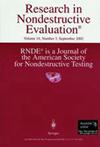Assessment of Laser-Generated Ultrasonic Total Focusing Method for Battery Cell Foil Weld Inspection
IF 1.6
4区 材料科学
Q3 MATERIALS SCIENCE, CHARACTERIZATION & TESTING
引用次数: 2
Abstract
ABSTRACT The feasibility of using laser-generated ultrasonic Total Focusing Method (TFM) was assessed for guided ultrasonic waves in finite plates. The application under consideration is for inspection of ultrasonically welded battery tab-to-electrode foil stack joints. The testing constraints for this weld necessitate couplant-free, remote, guided-wave conditions making laser ultrasonic TFM an ideal inspection technique. It was determined that laser-generated guided wave TFM can be used to remotely assess defects in a finite plate when the defects are strong reflectors in the plane of wave propagation. The finite dimensions of the tab require a strong understanding of the edge reflection effects on the TFM image. The guided wave modes used in this study were strongly affected by scattering due to the complex weld geometry, which most resembles that of a periodic triangular grated wave guide. Future work will investigate methods to compensate for the strong scattering/guided wave effects, the use of other guided wave geometries, out of plane TFM reconstruction for other weld defect types, as well as apodization effects.激光超声全聚焦法在电池箔焊缝检测中的应用
摘要:研究了激光超声全聚焦法(TFM)在有限板内引导超声中的可行性。正在考虑的应用是检查超声波焊接电池标签-电极箔堆叠接头。这种焊缝的测试限制需要无耦合剂、远程、导波条件,这使得激光超声TFM成为一种理想的检测技术。研究结果表明,当缺陷为波传播平面上的强反射体时,激光导波TFM可以用于有限板缺陷的远程评估。标签的有限尺寸要求对TFM图像上的边缘反射效果有深刻的理解。由于复杂的焊缝几何形状,本研究中使用的导波模式受到散射的强烈影响,其最类似于周期性三角形光栅波导。未来的工作将研究补偿强散射/导波效应的方法,其他导波几何形状的使用,其他焊接缺陷类型的面外TFM重建,以及apodization效应。
本文章由计算机程序翻译,如有差异,请以英文原文为准。
求助全文
约1分钟内获得全文
求助全文
来源期刊

Research in Nondestructive Evaluation
工程技术-材料科学:表征与测试
CiteScore
2.30
自引率
0.00%
发文量
14
审稿时长
>12 weeks
期刊介绍:
Research in Nondestructive Evaluation® is the archival research journal of the American Society for Nondestructive Testing, Inc. RNDE® contains the results of original research in all areas of nondestructive evaluation (NDE). The journal covers experimental and theoretical investigations dealing with the scientific and engineering bases of NDE, its measurement and methodology, and a wide range of applications to materials and structures that relate to the entire life cycle, from manufacture to use and retirement.
Illustrative topics include advances in the underlying science of acoustic, thermal, electrical, magnetic, optical and ionizing radiation techniques and their applications to NDE problems. These problems include the nondestructive characterization of a wide variety of material properties and their degradation in service, nonintrusive sensors for monitoring manufacturing and materials processes, new techniques and combinations of techniques for detecting and characterizing hidden discontinuities and distributed damage in materials, standardization concepts and quantitative approaches for advanced NDE techniques, and long-term continuous monitoring of structures and assemblies. Of particular interest is research which elucidates how to evaluate the effects of imperfect material condition, as quantified by nondestructive measurement, on the functional performance.
 求助内容:
求助内容: 应助结果提醒方式:
应助结果提醒方式:


